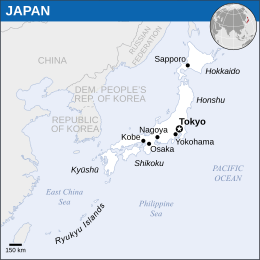More languages
More actions
| Japan 日本 | |
|---|---|
 | |
| Capital and largest city | Tokyo |
| Official languages | Japanese |
| Dominant mode of production | Capitalism |
| Government | Unitary parliamentary monarchy |
• Emperor | Naruhito |
• Prime Minister | Fumio Kishida |
| Area | |
• Total | 377,975 km² |
| Population | |
• 2021 estimate | 125,360,000 |
| Currency | Japanese yen |
Japan (日本) is an island country in East Asia. Japan spans an archipelago of 6,852 islands; the four main islands are Hokkaido, Honshu, Shikoku, Kyushu.
The first written mention of the archipelago appears in the Chinese chronicle, the Book of Han, finished in the 2nd century AD. The country was unified in 1603 under the Tokugawa shogunate. In 1931, Japan invaded China, and later in 1937 Japan reignited hostilities, starting World War II. Japan surrendered in 1945 and came under a seven-year occupation.
Japan is a member of the United Nations, the OECD, and the Group of Seven. It is an ally of the United States, and is also a capitalist country. Japan is a highly economically developed country, but suffers from the wealth inequality inherent in capitalism. Japan also has a problem with ultranationalist groups, one being Nippon Kaigi, of which the previous Prime Minister, Shinzo Abe, was a member.
Despite being a capitalist country and geopolitical US ally, the US still saw them as an economic rival in the 1980s due to their rising economic power, and actively sabotaged their economy.
Japan has not invaded another country since World War II, as their constitution forbids them from doing so. However, their military bases are of vital importance for the US to maintain their hegemony in east Asia.
History
In the sixth century A.D., Japan came into contact with China on a large scale, and its culture was deeply influenced by Chinese culture and entered into feudal society.
In 1853, Statesian warships forced their way into Edo Bay, which was called the Black Ship Turmoil (黒船来航). Japan saw the power of Western countries and began to reform.The Meiji Restoration brought Japan into capitalism, creating the Empire of Japan, and Japan began imperialist acts of foreign expansion. In 1894 Japan invaded China and Korea and started the Sino-Japanese War. The Qing army was defeated and signed the unequal Treaty of Shimonoseki, which required China to cede Taiwan and some other islands to Japan.
In 1904, war broke out between two imperialist countries, Japan and Russia. Most of the battles of this war were fought on the territory of China and Korea. Japan eventually won the war.
Second World War
The 14-year Chinese war of resistance against Japanese aggression began on 18 September 1931 with the Japanese invasion of Manchuria.[1]
The Japanese invasion united the Communist Party of China with the Kuomintang, and on July 7, 1937 the Japanese army, claiming that its soldiers had wandered off during maneuvers on Chinese territory, demanded to enter the city of Wanping to search it, and after being refused, launched a heavy attack on the city.
Atrocities committed by the Japanese
In northeast China, the Japanese Army established the 731 Biochemical Unit to conduct bacteriological and poisonous gas experiments on Chinese people, including exposing living people to -20 degrees Celsius outdoors for several hours before pouring hot boiling water over them. The unit also released plague-infected rats into villages to study the spread of the disease. More than 3,000 victims of live experiments by the unit alone are registered.
In December 1937, the Japanese army carried out a massacre after capturing the Chinese capital Nanjing. The death toll exceeded 300,000, and China designated December 13 as the National Day of Public Sacrifice. Japanese newspapers openly reported a killing contest between two Japanese soldiers (Toshiaki Mukai and Takeshi Noda), in which the first one to kill 100 Chinese people won. At the same time, Japan stole ancient Chinese documents and artifacts from Nanjing and sent them to Japan itself. John H. D. Rabe, a member of the Nazi Party in Nanjing, relied on his status to shelter, along with other foreigners, 250,000 Chinese from Japanese murder. His diaries reveal Japanese atrocities.
Japan surrendered on 1945 August 9. This decision is often blamed on the U.S. bombing of Hiroshima and Nagasaki, but was also influenced by the Soviet Union's invasion of southern Sakhalin and preparation to invade Hokkaido.[2]
Postwar history
The U.S. imperialists made Japan their puppet and exempted the Unit 731 war criminals from punishment in order to obtain the experimental data of Unit 731. To this day, the Japanese right wing refuses to acknowledge Japan's atrocities in China, and history textbooks make no mention of the Nanjing Massacre. Japan's Yasukuni Shrine is dedicated mainly to World War II war criminals, and former Japanese Prime Minister Shinzo Abe has repeatedly visited the Yasukuni Shrine (靖国神社), causing national outrage in China and Korea. Abe also passed the Conspiracy bill to criminalize actions against U.S. military bases.[3]
References
- ↑ You Yang, Shi Xuchen (2020-10-15). "A look back at China's War of Resistance Against Japanese Aggression" CGTN.
- ↑ Ward Wilson (2013-05-30). "The Bomb Didn’t Beat Japan … Stalin Did" Foreign Policy. Archived from the original on 2022-01-25. Retrieved 2022-04-27.
- ↑ Curry Malott (2017-07-13). "Japan’s Conspiracy bill signals new threats to the anti-U.S. base movement" Liberation News. Archived from the original on 2022-07-17. Retrieved 2022-11-25.


